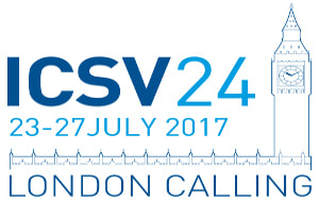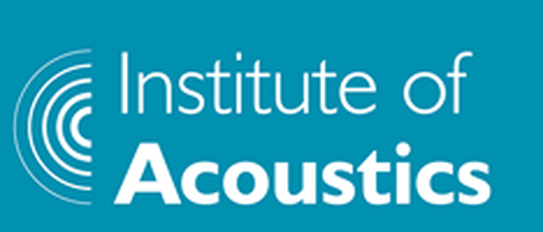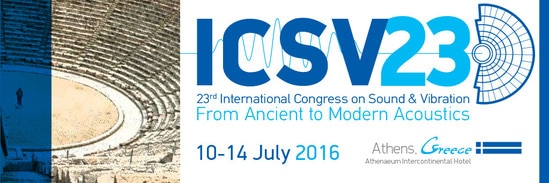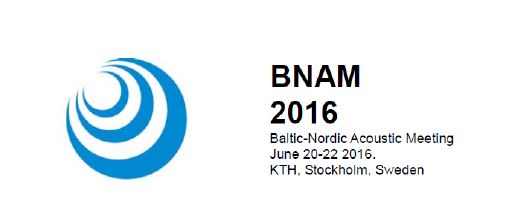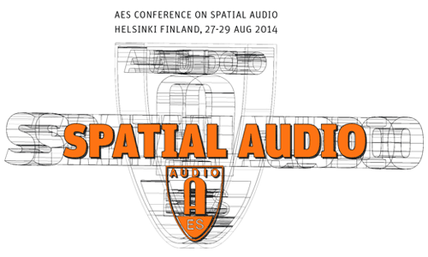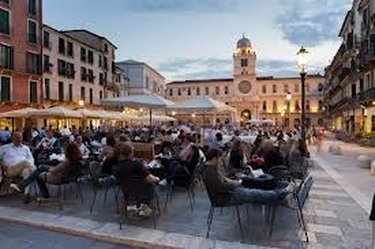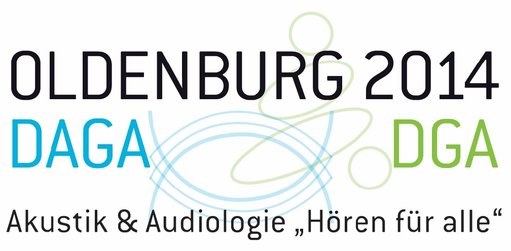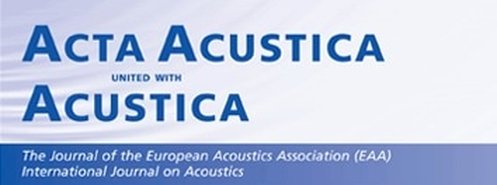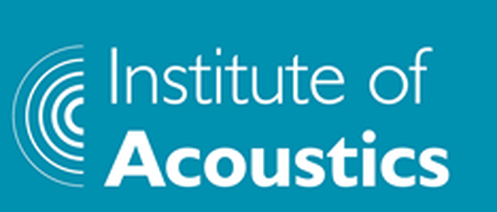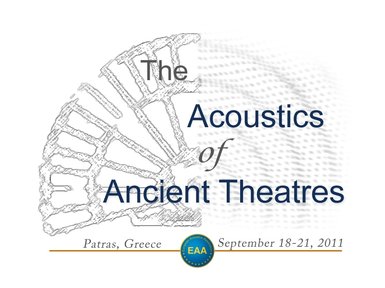EURONOISE 2018,
|
Paper
"Reverberation Time (RT) Calculation Based on Room Modal Decay and Using Wave Based Geometrical Acoustics (WBGA) and Modal Parameter Estimation" Authors Panos Economou, PEMARD Costas Economou, PEMARD Abstract In a previous paper, by the same authors, it was demonstrated that RT cannot be expressed as a continuous process in any domain; frequency, spatial or time. This paper is a continuation of the previous treatise, with the room being considered as a multi-resonant system. Its free vibrations, which aurally relate to reverberation, can be determined by the standard approach of the modal decay constant found in all linear systems irrespective of discipline. While in the previous paper, the methodology of implementing room modal RT was described for a cuboid room based on analytical expressions, this paper applies the same methodology for rooms of arbitrary shapes. With the use of Wave Based Geometrical Acoustics (WBGA) the transfer function (TF) of rooms of arbitrary shape is calculated. However, since resonances couple and overlap each other, the exact positions of modal frequencies become less evident. For this purpose, techniques of Vibration Modal Parameter Estimations used in Experimental Modal Analysis are applied here to detect resonant frequencies and their modal damping. |
EURONOISE 2018,
|
Paper
"The Significance of Sound Diffraction Effects in Ancient Theatres – Measurements and Simulations with and without Audience" Authors Panos Economou, PEMARD Costas Economou, PEMARD Abstract This paper examines the acoustics of ancient Greek-Roman theatres and the significance of sound diffraction effects taking place in the cavea. In a previous paper " The Significance of Sound Diffraction Effects in Simulating Acoustics in Ancient Theatres", it has been demonstrated how significant sound diffraction effects are in enriching the sound field in an ancient theatre by taking into account diffraction effects in an empty cavea. Sound diffraction is a scattering effect which disperses sound in many directions thus it allows listeners to perceive the sound of performers from the many scattering edges in the cavea before escaping to the surroundings. In essence unlike sound reflections, which are very few in open theatres, sound diffraction yields a precious part of the performers sound energy back to the audience thus creating a semi-diffused field. The theatre under study is a private school theatre, in the style of an ancient Greek theatre, where sound measurements were taken in 2011 with an empty cavea. For this paper, sound measurements were repeated there, with and without audience. The latter reveals more realistic conditions during performances. Sound measurements are compared to 3D wave-based geometrical acoustics simulations. The 3D theatre acoustical model was validated against sound measurements and wave interference effects analysis has shown that sound absorption and diffraction effects by an audience, provide indeed better speech acoustics. |
24th International Congress on Sound & Vibration
|
Paper
"Beyond Sabine: Investigating the Acoustical Phenomenon of Reverberation Using Room Modal Decay" Authors Panos Economou, PEMARD Costas Economou, PEMARD Panagiotis Charalampous, PEMARD Abstract The definition of Reverberation Time (RT) is based on a phenomenon which is far more complex than the definition is able to explain. Sabine in his effort to solve an engineering problem at first tackled the problem empirically and then tried to justify the findings of his empirical work within a theoretical framework by the use of many assumptions. Ever since then, the acoustical community tried to better understand the parameter described as RT confined within the original concept of Sabine which begins to converge on Sabine’s idea of RT above the Schroeder frequency. This paper tries to redefine the way we investigate this acoustical phenomenon without Sabine’s assumptions which are: (a) That an isotropic and homogeneous acoustical field exists within a room, (b) developed by sound reflections only, (c) due to plane wave sound propagation, (d) RT can be calculated using the borrowed concept of the Mean Free Path from particle physics and optics, (e) the use of sound absorption coefficients and (f) energy summation. This paper studies room modal decay using (i) spherical wave propagation, (ii) surface impedance (iii) a sound field formed by sound reflections and diffractions and (iv) sound pressure summation preserving wave front phase information. |
Wind Turbine Noise 2017, Rotterdam
|
Paper/Poster
"Wind turbine noise prediction using Olive Tree Lab Suite" Authors Alexis BIGOT, SIXENSE Environment Panos ECONOMOU, PEMARD Costas ECONOMOU, PEMARD Abstract Calculation of noise propagation from wind turbines is complex, and large variations of sound immission levels are commonly observed at the same wind speed. These variations are influenced by sound emission (aerodynamic noise), but also by meteorological parameters such as temperature gradient, wind speed profile, wind direction, and turbulences. Commonly used models (ISO 9613-2 and Nord2000 for example) generally predict the average sound pressure levels adequately under downwind conditions, but often fail to predict noise levels in upwind conditions. In this paper we present the results of a collaborative research between SIXENSE Environment (ex SOLDATA Acoustic) and P.E Mediterranean Acoustics Research & Development (PEMARD), using on site experience on more than 350 French windfarms, and Olive Tree Lab - Suite v4.0 software which uses wave based geometrical acoustics to calculate sound propagation, including atmospheric refraction. The goal is to combine both approaches and introduce and test key parameters for wind turbine noise prediction. Calculation results are compared to long term noise & meteorological measurements. A good correlation is shown between calculation and measurements even in case of complex meteorological situations. |
London Branch Meeting
|
Presentation
"An integrated approach in Acoustics - sound propagation and the phenomena affecting it" Authors Panos Economou Abstract Whether indoors or outdoors, sound propagation is affected by the same phenomena, mainly reflection, diffraction, refraction and transmission. We present the approach of integrated acoustics, which irrespective where sound propagation takes place, and with the use of surface impedance, image source method and sound pressure summation, these phenomena can be taken into account to calculate room modes, the seat dip effect, atmospheric refraction and sound scattering, to mention a few. This talk will present cases where the integrated approach in acoustics is a prerequisite in order to calculate real life scenarios using Olive Tree Lab Suite. |
23rd International Congress on Sound & Vibration
|
Paper
"IMPROVED ROOM ACOUSTICS CALCULATIONS USING COMPLEX IMPEDANCE AND SPHERICAL WAVE REFLECTION & DIFFRACTION COEFFICIENT" Authors Panos Economou, Panagiotis Charalampous Abstract Until recently geometrical acoustics has been considered an approximate method of calculating the sound field within a 3D environment because of certain limitations in existing methods. Geometrical acoustics mostly refers to the use of ray tracing and image sources. Ray tracing is a pure energetic method, while the image source method, despite calculating complex sound pressures and theoretically representing a solution to the wave equation, has certain limitations. One of the limitations found in most of the image source implementations is the use of plane wave reflection coefficient and absorption coefficients, a fact that prohibited image sources to be an exact solution of the wave equation. In this paper we extend the image source method, using spherical wave reflection and diffraction coefficients as well as complex surface impedance. We compare the results of the calculations with published data and we conclude that the use of spherical wave coefficients and complex impedance can improve room acoustics predictions. |
23rd International Congress on Sound & Vibration
|
Paper
"ROOM RESONANCES USING WAVE BASED GEOMETRICAL ACOUSTICS (WBGA)" Authors Panos Economou, Panagiotis Charalampous Abstract Geometrical acoustics, using plane wave propagation and sound absorption coefficients, fail to calculate room resonances. Usually such wave phenomena are being calculated with numerical methods such as Finite Element Method or similar which are computationally heavy. The WBGA, which is based on the image source method, spherical wave propagation, impedance discontinuities and sound pressure summation, can accurately simulate room resonances both in the frequency and spatial domain. In this paper we present calculation results of room resonances using the WBGA compared to published data. |
23rd International Congress on Sound & Vibration
|
Paper
"THE SEAT DIP EFFECT USING WAVE BASED GEOMETRICAL ACOUSTICS (WBGA)" Authors Panos Economou, Panagiotis Charalampous Abstract The seat dip effect is considered to be one of the intractable acoustical phenomena in room acoustical simulations. This phenomenon is mainly due to edge sound diffraction and scattering. Wave Based Geometrical Acoustics (WBGA), which originates from the image source method, spherical wave propagation, impedance discontinuities and sound pressure summation, accounts for wave phenomena such as reflection from planes, diffraction from edges, refraction due to stratification of mediums to mention a few. By applying WBGA, we demonstrate that the seat dip effect can be accurately calculated and predicted. This paper compares results of the seat dip effect calculated using WBGA with published and measured data. |
23rd International Congress on Sound & Vibration
|
Paper
"AN IMPROVED USER-INDEPENDANT ALGORITHM FOR ROOM ACOUSTIC PARAMETERS CALCULATIONS" Authors Panagiotis Charalampous, Panos Economou Abstract We present a novel algorithm for room acoustic parameters calculation which addresses one of the major uncertainties in room acoustics prediction, that of user defined termination criteria. One of the uncertainties in room acoustics predictions that take place using geometrical acoustics methods is the user defined termination criteria. Ray tracing algorithms require maximum length and number of rays to be send. Image source algorithms require maximum reflection orders and/or maximum sound attenuation. Our algorithm adjusts progressively its termination criteria until a correct result is approximated, based on an intelligent guessing, therefore removing this burden and risk from the user. We explain the algorithm’s termination procedure and we compare with typical implementations. We show that the results approximate measurements equally well or better, having the benefit that the user does not need to worry anymore about these settings. |
Bi-annual Baltic-Nordic Acoustic Meeting
|
Paper
"Using Wave Based Geometrical Acoustics (WBGA) to investigate room resonances" Authors Bengt Johannson, Panos Economou, Antreas Eleftheriou Abstract Room modes can easily be calculated for simple room shapes using analytical equations. When room shapes are irregular, room wave phenomena can be calculated using numerical methods such as Finite Element Method or similar which are computationally heavy. Conventional geometrical acoustics, using plane wave propagation and sound absorption coefficients, fail to calculate room resonances. In contrast, Wave Based Geometrical Acoustic, WBGA, based on the image source method, spherical wave propagation, impedance discontinuities and sound pressure summation, can accurately simulate room resonances both in the frequency and spatial domain. This paper presents room resonances simulations using the WBGA and compares them to measured data. |
20th International Conference on Virtual Systems and Multimedia.
|
Paper
"Sound Propagation in 3D Spaces Using Computer Graphics Techniques" Authors Panagiotis Charalampous, Despina Michael Abstract Sound propagation in 3D spaces is governed by similar physical principles as light. As a result, sound rendering in a 3D virtual environment can benefit from methods developed for graphics rendering and vice versa. In this review, we provide an overview of methods used for sound rendering that share concepts and techniques with graphics rendering. Firstly we describe geometrical propagation techniques where the computations are based on ray theory similar to ray tracing techniques in computer graphics. Secondly, we review numerical techniques. These techniques, similar to the idea of radiosity, are based on the subdivision of the space into elements. Then we describe acceleration techniques that can be used in combination with other methods to speed up calculations. Lastly, for the sake of completeness, a quick overview is given of sound computation techniques that simulate specific sound effects that do not apply on illumination. The aim of this survey is to share knowledge among the two disciplines using familiar and known concepts. |
NOISE-CON 2014
|
Paper
"Accuracy of wave based calculation methods compared to ISO 9613-2" Authors Panos Economou, Frank Brittain, Panagiotis Charalampous Abstract Ray-tracing software, which uses ISO 9613-2 to compute outdoor propagation, is practical, and has been used successfully for design. However, serious doubts exist regarding the accuracy of some of the various empirical algorithms used, such as algorithms for ground effects and reflections, source height, reflections by objects, and ground cover. Further, 9613-2 has no algorithms for turbulence, phase, and wave length (except barrier diffraction). New wave-based image-source software (Olive Tree Lab-Terrain by PEMARD) uses theoretically accurate 3-dimensional algorithms that agree more closely with measurements than 9613. It takes into account reflections from finite impedance surfaces and finite-sized objects, applying Fresnel zone corrections as well as diffractions of unlimited orders from edges. The new software also calculates constructive and destructive interferences that are not possible with simpler algorithms, including 9613-2. Full-wave solutions (such as Greens Function-Parabolic Equation), which can also calculate wave-length effects, are usually too computation-intensive for design. The new software is computationally practical for the very large number of sources and sub-sources that are typically modeled during design. This paper compares results of calculations using selected advanced calculation algorithms from OTL-Terrain with measurements and those from 9613-2 both as a function of frequency and distance. |
AES 55TH Conference on Spatial Audio
|
Paper
"Tree Traversal Algorithms for Real Time Sound Propagation Calculation" Authors Panagiotis Charalampous, Despina Michael Abstract A major category of algorithms for simulating sound propagation in three dimensional environments is the category of geometrical acoustics which are based on various tracing techniques. All tracing techniques are essentially tree traversals throughout a tree of candidate sound paths which could potentially affect the sound field at a given receiver location. Even though there is significant literature for speeding up tracing in three dimensional spaces for use in real time applications, the type of these algorithms has barely been discussed. In this work, we implement an image source method variant and we compare three different tree traversal approaches, depth-first, breadth-first and best-first. We examine their performance in respect to time and we highlight the advantages and disadvantages of each one and evaluate the applicability of each in real time sound propagation calculations. |
New Approach to the Control of Environmental Noise - Seminar
|
Initiative sponsored by the Municipality of Padua and ISPRA, looking for ideas, technical and practical approaches to new and constructive problem solving of noise affecting typical Italian city centres where complex architectural structures hinder remedial measures.
|
40th Annual German Congress on Acoustics (DAGA 2014),
|
Paper
"From Theory to Practice: Advanced calculation methods applied in OTL – Terrain" Authors Panos Economou, Panagiotis Charalampous Abstract The path from a noise source to a receiver involves complicated mechanisms such as diffractions and reflections from ob- stacles, ground and material properties, as well as meteorological conditions. In this paper, we present the methodology applied by P.E. Mediterranean Acoustics Research & Development for outdoor sound propagation applying advanced calculation methods for prediction and simulation purposes in a software application. The methodology makes use of the image source method combined with visibility tracing techniques to implement a novel method of multiple path- detection, taking into account reflections from finite impedance surfaces and finite-sized objects applying Fresnel zone corrections as well as diffractions of unlimited orders from edges. These advanced methods are no longer used only in the laboratory but are now available to engineers in the field, making theory available in practice. Some examples are also presented. Keywords Environmental acoustics, geometrical acoustics, diffraction, prediction, simulation, computational acoustics, noise barrier, ground effect, surface impedance. |
Audio Engineering Society 49th International Conference on Audio for Games
|
Paper
“A Framework for the development of accurate acoustic calculations for games” Authors Panagiotis Charalampous, Panos Economou Abstract Despite the rapid development in acoustics calculation software during the last couple of decades, such advances have not been achieved uniformly. Various demands in different disciplines have shifted the focus to a number of different aspects of the calculations. Methods in game development have focused on speed and optimized calculation times to achieve interactive sound rendering, whilst engineering methods have concentrated in achieving accuracy for reliable predictions. This paper presents a flexible, expandable and adjustable framework for the development of fast and accurate acoustics calculations both for game development and engineering purposes. It decomposes the process of acoustic calculations for 3D environments into distinct calculation steps and allows third party users to adjust calculation methodologies according to their needs. |
ACTA ACUSTICA United with ACUSTICA Journal of the Euopean Acoustics Association (EAA)
|
|
Acta Acustica united with Acustica, Volume 99,Number 1, January/February 2013 , pp. 48-57(10)
Publisher:S. Hirzel Verlag |
Paper
"The Significance of Sound Diffraction Effects in Simulating Acoustics in Ancient Theatres."
Authors
Panos Economou, Panagiotis Charalampous
Abstract
This paper examines the effect of sound diffraction in predicting sound propagation in ancient theatres. Few simulation studies to date concerning ancient theatre acoustics have been conducted with diffraction effects. While sound diffraction effects in ancient theatres are known qualitatively, rarely have they been quantitatively documented. In this paper, the ancient theatre of Kourion in Cyprus was acoustically modelled and simulated, in a commercially available software application which also handles sound diffraction to high orders. Sound measurements were also taken at the theatre for comparison purposes. Comparison of results of the variation of sound pressure level with distance and frequency shows that the contribution of sound diffraction is significant.
"The Significance of Sound Diffraction Effects in Simulating Acoustics in Ancient Theatres."
Authors
Panos Economou, Panagiotis Charalampous
Abstract
This paper examines the effect of sound diffraction in predicting sound propagation in ancient theatres. Few simulation studies to date concerning ancient theatre acoustics have been conducted with diffraction effects. While sound diffraction effects in ancient theatres are known qualitatively, rarely have they been quantitatively documented. In this paper, the ancient theatre of Kourion in Cyprus was acoustically modelled and simulated, in a commercially available software application which also handles sound diffraction to high orders. Sound measurements were also taken at the theatre for comparison purposes. Comparison of results of the variation of sound pressure level with distance and frequency shows that the contribution of sound diffraction is significant.
Meeting on "Environmental Noise Propagation - Definitions, measuring and control aspects"
|
Paper
“A comparison of ISO 9613 and advanced calculation methods using Olive Tree Lab-Terrain, an outdoor sound propagation software application: Predictions versus experimental results” Authors Panos Economou, Panagiotis Charalampous Abstract The process of performing an Environmental Impact Assessment includes the study of noise propagation. Often, the path from a noise source to a noise sensitive location involves complicated mechanisms of sound transmission. These mechanisms may relate to diffraction & reflections from obstacles (natural or man made), ground properties, and meteorological conditions. The International Standards Organization proposes with standard ISO9613-2, methods by which to calculate these effects. While they are relatively easy to implement, they underestimate the true workings of the aforementioned mechanisms. In this paper, we present the OTL - Terrain software application, which accurately and precisely simulates outdoor sound propagation. The software application can be used for the prediction of environmental noise and the design of control measures. OTL - Terrain is an application which uses geometrical acoustics (GA) and models the propagation of sound in terms of rays. The tool makes use of the image source method (ISM) combined with visibility tracing techniques to implement a novel method of path-detection, taking both reflection and diffraction effects into account. Calculations utilize the predicted reflections from finite-sized objects with Fresnel zone corrections, an unlimited order of diffraction, and atmospheric turbulence. This paper presents a comparison of the predictions made by the OTL – Terrain application, the methods proposed by ISO, and the published results from experimental data. |
European Acoustics Association & Hellenic Institute of Acoustics Conference
|
Paper
"The Significance of Sound Diffraction Effects in Predicting Acoustics in Ancient Theatres." Authors Panos Economou, Panagiotis Charalampous Abstract This paper examines the effect of sound diffraction in predicting sound propagation in ancient theatres. Few simulation studies to date concerning ancient theatre acoustics were conducted with diffraction effects. While sound diffraction effects in ancient theatres are known qualitatively, rarely have they been quantitatively documented. In this paper, the ancient theatre of Kourion in Cyprus was acoustically modeled and simulated, in a commercially available software application which handles also sound diffraction to high orders. Sound measurements were also taken at the theatre for comparison purposes. All analyses were conducted in the frequency domain. Comparison of results of the variation of sound pressure level with distance and frequency shows that the contribution of sound diffraction is significant. It is proposed that future acoustical simulations of ancient theatres should include sound diffraction effects. |


